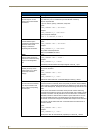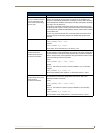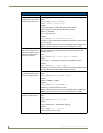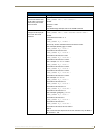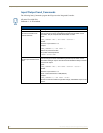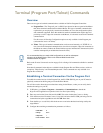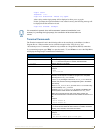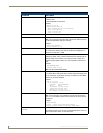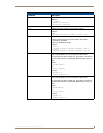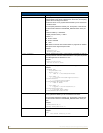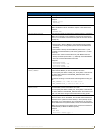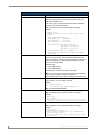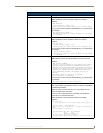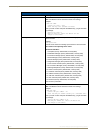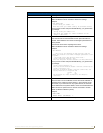
Terminal (Program Port/Telnet) Commands
94
NI Series WebConsole & Programming Guide
Terminal Commands (Cont.)
Command Description
DNS LIST <D:P:S> Displays the DNS configuration of a specific device including:
• Domain suffix·
• Configured DNS IP Information
Example:
>DNS LIST [0:1:0]
Domain suffix:amx.com
The following DNS IPs are configured
Entry 1-192.168.20.5
Entry 2-12.18.110.8
Entry 3-12.18.110.7
ECHO ON|OFF Enables/Disables echo (display) of typed characters.
GET DEVICE HOLDOFF Displays the state of the Master’s device holdoff setting.
Note: This command reveals the state of the device holdoff set using
the DEVICE HOLDOFF ON|OFF command.
Example:
>GET DEVICE HOLDOFF
Device Holdoff is off.
GET DUET MEMORY Display the amount of memory allocated for Duet Java pool. This is
the current Java memory heap size as measured in Megabytes. An
example is a value of 5 = 5 MB.
GET ETHERNET MODE Displays the current ethernet configuration setting.
Settings are either "auto" in which the ethernet driver will discover it's
settings based on the network it is connected to OR <speed> and
<duplex> where speed is either 10 or 100 and duplex is either full or
half.
Example:
>GET ETHERNET MODE
Ethernet mode is auto.
Note: See SET ETHERNET MODE.
GET IP <D:P:S> Displays the IP configuration of a device.
If you enter GET IP without the D:P:S variable, the Master displays it’s
D:P:S, Host Name, Type (DHCP or Static), IP Address, Subnet Mask,
Gateway IP, and MAC Address.
Example:
>GET IP [0:1:50]
IP Settings for 0:1:50
HostName MLK_INSTRUCTOR
Type DHCP
IP Address 192.168.21.101
Subnet Mask 255.255.255.0
Gateway IP 192.168.21.2
MAC Address 00:60:9f:90:0d:39
HELP SECURITY Displays security related commands.
Note: This command is only available to Program Port terminal ses-
sions. It is not available to Telnet sessions (see the Overview section
on page 91).
Example:
>HELP SECURITY
>logout Logout and close secure session
>setup security Access the security setup menus
ICSPMON ENABLED|DISABLED
[PORT]
Enables or disables ICSP monitoring out the specified IP port.
By enabling icspmon on an IP port, an external application could con-
nect to that port and "listen" on the ICSP traffic.



